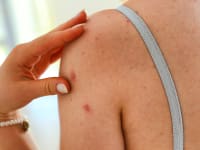What your acne means, according to its location on your face
Plus products to stave off breakouts
Products are chosen independently by our editors. Purchases made through our links may earn us a commission.
Breakouts happen to nearly everyone. And blemishes can occur for a variety of reasons, from hormonal zits to diet habits to irritating products. Before you begin to heal these bothersome spots and bumps, it’s essential to figure out what’s causing the reaction in the first place.
Though it’s only one piece of the puzzle, where your breakouts are on your face (or body) can be a helpful indicator of the cause. Before getting into what your acne's location may mean, know that it’s always wise to book an appointment with your dermatologist to discuss your unique skin, especially if your condition doesn’t improve or becomes worse despite treatments. A healthcare provider will consider many factors, including your personal history as well as the distribution, morphology, and severity of acne to generate a diagnosis, explains Dr. Macrene Alexiades, an associate clinical professor at the Yale University School of Medicine, and the founder and director of the Dermatology and Laser Surgery Center of New York.
What you should know about nose acne
Those with oily skin may notice the nose as a blemish-prone area. Blemishes on the nose are often blackheads (pores clogged with oil or dead skin that oxidize to appear darker) or whiteheads (pores clogged with oil, dead skin, and bacteria that appear white).
“Consider using a clay or sulfur-based mask on your nose once a week to help keep your pores decongested and avoid the application of heavy or rich formulas on your nose overall,” says Dr. Geeta Yadav, a board-certified dermatologist and the founder of Skin Science Dermatology. The Peter Thomas Roth Therapeutic Sulfur Acne Treatment Mask contains 10% sulfur, the maximum allowed in over-the-counter masks, as well as kaolin and bentonite clays to absorb oil, and aloe vera to hydrate.
If you tend to experience inflamed-looking acne only on your nose, Alexiades says you could have a skin condition called rosacea. There are several ways rosacea can manifest on the skin, with one being the presence of raised skin and small bumps around the nose area typically caused by an increase in histamine levels. Alexiades explains that common triggers include red wine, heat and sun, cheese, chocolate, and deep-sea fish. In addition to cutting back on those menu items to see if it improves, you can also try products with azelaic acid to combat the redness.
Products with azelaic acid are often prescribed by dermatologists, but there are some lower-percentage options (10% concentration) available over the counter. One top pick is The Ordinary Azelaic Acid Suspension, which claims to brighten your tone and smooth texture, as well as fight blemishes and provide antioxidants for protecting your skin.
What you should know about forehead acne
If you have pesky zits that form above your brow and your hairline, it could be from your moisturizer or even hair care products that leave residue on your skin. “Often, blemishes in this area are standard whiteheads or small blackheads, often due to excess oil production,” Yadav says.
In addition to using non-comedogenic and oil-free formulas in this area of the face, Yadav recommends drinking plenty of water, especially in the colder months. “Dehydrated skin tends to overproduce oil in attempts to compensate for the dry air, which leads to congestion,” she says. Also, it may seem like a no-brainer, but if you suffer from ongoing forehead breakouts, make sure you thoroughly cleanse the skin of hair products in the shower—conditioner especially can clog pores. To unclog your skin, Yadav suggests using a cleanser with salicylic acid, as it seeps deep into the pores to fight bacteria and prevent dead skin cells from building up.
For a daily cleanser that’ll keep your skin clear, try the Murad Acne Control Clarifying Cleanser. It contains 1.5% salicylic acid to break down build-up and leave your pores squeaky clean and green tea to calm irritation. If you already have a cleanser you like, another option is the Paula’s Choice BHA 2% Liquid Exfoliant, which contains 2% salicylic acid and green tea for the same purposes but can be applied using your fingers or a cotton pad post-cleanser and pre-moisturizer.
If you need a reminder to keep chugging water throughout the day, try the Brita BB11 Premium Filtering Water Bottle, our top pick after testing the best water bottles. We love how cold it keeps water and how easy it is to open one-handed, making it ideal for sipping while commuting, working, or walking around.
What you should know about cheek acne
Cheek acne typically consists of deeper cysts, which “can be addressed with benzoyl peroxide, an excellent ingredient for treating inflammatory acne,” says Yadav. The PanOxyl Antimicrobial Acne Foaming Wash contains 4% benzoyl peroxide to ward off breakouts, as well as hydrating glycerin to quench and soothe skin. Though it’s a daily cleanser, consider integrating the face wash gradually (once or twice a week at first), as it may be drying until your skin adjusts.
Also, you can limit bacteria and stave off cheek breakouts by avoiding touching your face, washing your pillowcases at least once a week, and regularly disinfecting your phone. “You should also consider washing your face after coming home for the day to rinse away all the pollution and environmental impurities your skin has accumulated during the day,” Yadav says.
What you should know about jawline and chin acne
Acne that borders your lower face is associated with hormonal imbalances that may relate to the menstrual cycle or a condition such as polycystic ovarian syndrome (PCOS), Yadav says. “Blemishes here tend to be painful cysts or pustules, which respond well to benzoyl peroxide,” she says.
The PanOxyl Antimicrobial Acne Foaming Wash works here, too. But if you’d prefer a treatment you integrate in between your cleanser and moisturizer, try the Paula’s Choice Regular Strength Daily Skin Clearing Treatment that claims to clear up skin with 2.5% benzoyl peroxide and soothe redness and irritation with bisabolol and allantoin.
It’s also worthwhile to take a look at your diet if you deal with jawline and chin acne. “There is a strong correlation between your digestive system and hormones; many people find that avoiding dairy, sugar, and gluten—all inflammatory foods—can help quell blemishes along the chin and jaw,” Yadav says. Consult your dermatologist about your skin and if they agree that diet changes could lead to the results you want, consider seeing a dietician for guidance.
Prices were accurate at the time this article was published but may change over time.


